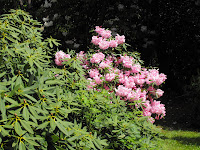 e otherwise hot sunshine. We walked the perimeter from the car parking area where new building is going on to construct a toilet block, kiosk and a visitor's centre. The sign informed us that cattle grazed the meadow land but we saw none and instead enjoyed the buttercups and clover that peeped out of the grass creating a glow that complimented the fresh green of the trees and shone like golden butter in the sunshine.
e otherwise hot sunshine. We walked the perimeter from the car parking area where new building is going on to construct a toilet block, kiosk and a visitor's centre. The sign informed us that cattle grazed the meadow land but we saw none and instead enjoyed the buttercups and clover that peeped out of the grass creating a glow that complimented the fresh green of the trees and shone like golden butter in the sunshine. heir brood along like a flotilla of small ships. We also had the treat of watching a mother with her boy and a baby girl feeding the ducks and a friendly squirrel and a pair of water voles who decided to partake of the treat.
heir brood along like a flotilla of small ships. We also had the treat of watching a mother with her boy and a baby girl feeding the ducks and a friendly squirrel and a pair of water voles who decided to partake of the treat. The country park is a mixture of easy walking, play area for children and will give families a chance to get together and play games of have a picnic. The family we met are regular users of the
park and told us much about the Swans' progress with their family - the boy told us about how to feed the ducks and the cheeky squirrel. Most enjoyable.

 centre that could also be defended if need be.
centre that could also be defended if need be. St Leonard's Tower
 The centre of West Malling is attractive with Tudor buildings and many others of later eras that track the progress of the main street from earlier times to the twentieth century. Some buildings have Georgian and Victorian facades built on to early buildings. A pleasant mixture of ancient and almost modern.
The centre of West Malling is attractive with Tudor buildings and many others of later eras that track the progress of the main street from earlier times to the twentieth century. Some buildings have Georgian and Victorian facades built on to early buildings. A pleasant mixture of ancient and almost modern.A Tudor house in King Street
 sidence who run retreats (allowing visitors to have respite time) and she told us of the gardens and the cascade further along the road.
sidence who run retreats (allowing visitors to have respite time) and she told us of the gardens and the cascade further along the road. The stream cascades from an arch in the wall of the Abbey.

A general concensus (we polled each other and the person working at the Abbey and the old gentleman we met ) was that the village was crowded with vehicles. We learned that medieval gates were likely to be short lived simply because cart drivers would crash into them and cause damage. Speeding carts seemed to match the excessive speed of those drivers who negotiated the narrow confines of West Street with a few exceptions, namely the police patrol car and a motorcyclist who drove carefully past the cafe. The speed limit is 20mph in the precincts.
 ng Street by which we returned to West Street after first taking a short excursion down a side road. We had a pleasant chat with an 89 year old resident who recommended the Bull Inn across the road for a decent pint; which was only right, he should know.
ng Street by which we returned to West Street after first taking a short excursion down a side road. We had a pleasant chat with an 89 year old resident who recommended the Bull Inn across the road for a decent pint; which was only right, he should know. A view along King Street
























